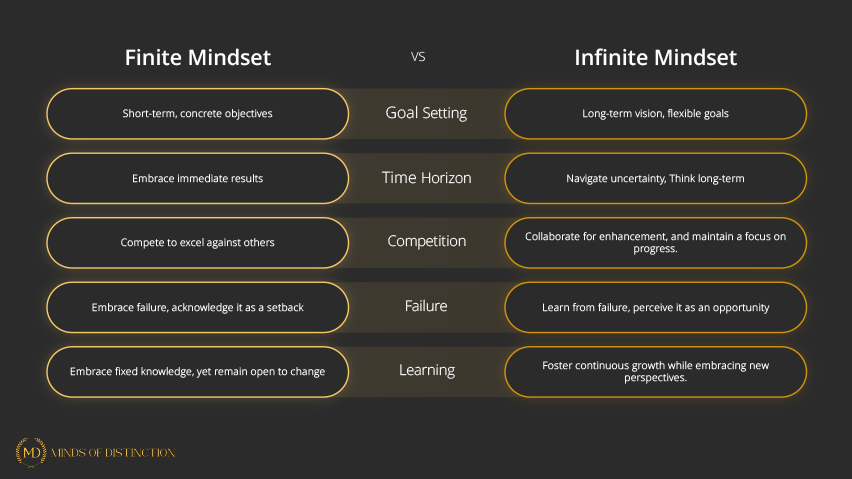Play to Outlast: Shifting from a Finite to an Infinite Mindset
Quarterly targets matter—but your real advantage is the ability to keep improving when conditions, competitors, and constraints all change. The finite mindset optimizes for short-term wins; the infinite mindset compounds value over time. Explore the contrast between the two across five levers—Goal Setting, Time Horizon, Competition, Failure, and Learning. It serves as a powerful checklist for how to lead and build resilient and growth-oriented teams.
Five Shifts That Change Everything
1) Goals: From tasks to a long-term vision
- Finite: Short-term, concrete objectives.
- Infinite: A durable vision with flexible goals that can adapt without losing direction.
Try this: Anchor every sprint goal to a multi-year narrative (“What are we building toward?”). When facts change, adjust the goal—not the vision.
2) Time: From immediacy to intelligent patience
- Finite: Chase immediate results.
- Infinite: Navigate uncertainty; think long-term.
Try this: Pair leading indicators (quality, learning velocity) with lagging ones (revenue, uptime). Celebrate early signs of right movement, not just end-state wins.
3) Competition: From beating rivals to elevating the field
- Finite: Compete to excel against others.
- Infinite: Collaborate for collective enhancement; focus on progress.
Try this: Replace “rankings” meetings with “advantage reviews”: how did we get better this cycle—process, product, or people? Bring partners and even customers into the improvement loop.
4) Failure: From setback to source code
- Finite: Acknowledge failure as a setback.
- Infinite: Treat failure as an opportunity to learn.
Try this: Run a 15-minute learned-last at the end of key efforts: one insight to keep, one to fix, one bet to try next. Archive these in a living “field notes” or “lessons learned” log.
5) Learning: From fixed knowledge to continuous growth
- Finite: Hold tight to what you know (even while “open to change”).
- Infinite: Systematically seek new perspectives and build capability.
Try this: Budget time and money for learning sprints—short courses, cross-team shadowing, peer demos—then require a “teach-back” to spread the gain.
A Simple Operating Rhythm (you can start this week)
- Mondays – Vision tether (10 min): Read the one-sentence vision at the top of the agenda. Ask, “How does this week move us toward our goals?”
- Midweek – Progress standup (15 min): Win / Block / Thanks, plus one metric of learning velocity (e.g., experiments run, assumptions retired).
- Fridays – Advantage review (20 min): What enduring capability did we improve? What will compound next week?
- Monthly – Adaptation checkpoint (30–45 min): If conditions changed, which goals flex—without abandoning the long-term aim?
Leader Moves That Signal “Infinite”
- Resource the horizon: Protect 10–20% of capacity for bets that won’t pay off this quarter or to hedge against not yet known challenges.
- De-risk curiosity: Publicly reward smart experiments—even null results. Encourage critical and creative thinking among the team.
- Make progress visible: Show trendlines, not just snapshots. Share with the team often.
Short-term wins keep the lights on; an infinite mindset keeps the mission alive and the troops engaged. Lead with vision, patience, collaboration, learning, and a healthy relationship with the occasional failure—and you’ll build teams that improve faster than the problems they face.
Audit where you’re finite, choose one lever, and make the shift this week.







